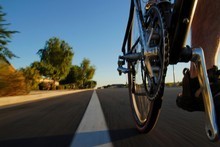
It would be some small comfort to those who mourn Jane Bishop to know that her death spurred some action on making city streets safer for cyclists.
Bishop died in November 2010 after falling under a truck on Tamaki Dr after her cycle struck Glenn Becker, who had just opened his car door.
Becker was acquitted this week of a charge of careless use of a motor vehicle causing death, a verdict that seemed consistent with the evidence. As the tireless spokeswoman for the Cycle Action lobby group, Barbara Cuthbert, remarked, he was "the fall guy" for an inadequate piece of roading, as surely as Jane Bishop was the victim.
Not all drivers are as blameless; as the city's intrepid cycling community will ruefully attest, door are flung open in their paths every day. With a little luck, the wide coverage of this incident and its legal aftermath will make all drivers look out for cyclists a little more closely, but stupidity can never be eradicated - least of all by regulation. What can be improved is the road network that motorists and cyclists share.
What emerges clearly from this sorry affair is that the "pinch-point" piece of road where Jane Bishop died was an accident waiting to happen. The space between the line of moving traffic and the line of parked cars at that point was, on November 17, 2010, just wide enough to accommodate both Glenn Becker and Jane Bishop, but there was no margin for the error that, in this case, proved fatal.
Within two days of the death, the pinch-point problem was solved by the removal of some parking spaces, but council officials had been told about it for years and have yet to explain, much less apologise for, their inaction which in other jurisdictions would see them civilly, if not criminally, liable.
The idea that an audit of such danger spots on popular cycling routes (followed by their immediate improvement) should be simply the first step in setting up a comprehensive system of cycle paths around the isthmus may seem radical to many Aucklanders.
In discussions of public transport, we are accustomed to shrugging our shoulders and saying that this is a car city.
But such a defeatist response ignores such projections as those in a Transport Ministry report published this week, which predicts midday traffic jams within 20 years.
Cyclists, in particular those who commute, are not obscure oddball hobbyists; they are the trailblazers of a transport future whom we should applaud and accommodate. Those riders whose fluoro backpack-covers ungrammatically proclaim they mean "one less car" on the road are stating a literal truth: each cyclist contributes to easing congestion and competition for parking and they deserve to be treated with gratitude.
Yet our roading network is a hostile environment for cyclists. Lane systems that allow traffic either to turn right or go straight ahead make it impossible for a cyclist to choose a line that is guaranteed not to come into conflict with cars. And cycle lanes, where they exist at all, are narrow and not separated from the carriageway by raised kerbing.
It is commonly believed that the great "cycle cities" of Europe, notably in the Netherlands, have always been that way. Motorists are required by strict (and strictly enforced) law to make life easy for cyclists.
But in fact the cycle culture that grew up in the early 20th century, when bikes hugely outnumbered cars, was swept away by a wave of increased car ownership in the prosperous postwar years. It was only furious public pressure after many cyclist deaths, and then the 70s spikes in oil prices, that forced the wholesale building of wide, isolated cycleways.
It is well past time that we followed the Dutch example. It does not require great capital investment, just the appropriation of some existing carriageway, making dual-lane roads single-lane and cutting back roadside parking.
As cycling becomes safer, more people will saddle up. And fragile cyclists in snarls of traffic will live longer.
At the same time, some cyclists would do their cause a favour by displaying a bit more respect for the rules of the road. A bicycle is a vehicle under the law and if a cyclist wants to be defined as something other than a vehicle user, it takes no effort to dismount and become a pedestrian for a few moments.
They don't hold the Tour de France in heavy traffic. Rush-hour cyclists would do well to have rush-hour expectations.
From Herald on Sunday
